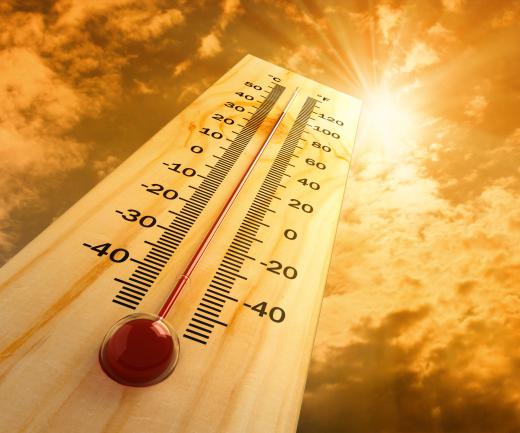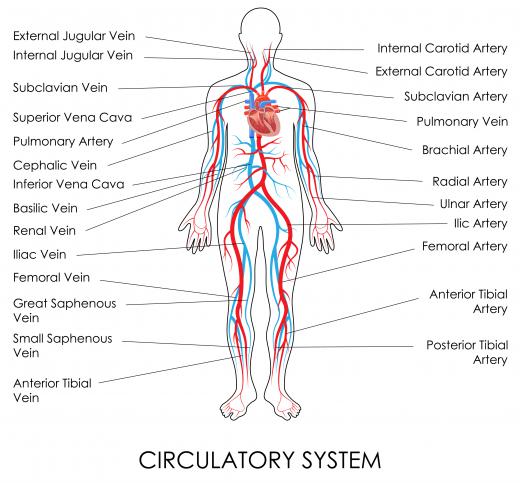What is Convective Heat Transfer?
Convective heat transfer is the transfer of heat through means of convection, the transfer of heat through fluid motion. Convective heat transfer can occur in one of two major ways: through natural convection and through forced convection. These two methods of heat transfer are distinguished by the use, or lack of, external devices to move the heated fluid around. In either case, the transfer of heat occurs by a fluid-- such as a liquid, gas, or a rheid-- flowing over a solid mass.
One example of convection is water boiling in a pot. As the water near the heat source gets warmer, the molecules spread apart. This causes the water to become less dense and more buoyant. The more buoyant water rises to the top of the pot and cooler water takes its place. The cooler water will then get heated by the heat source, become less dense, and rise to the top.

This process results in a current called a convection current. In the case of water boiling, it becomes more visible when something like macaroni is in the pot-- one will see the macaroni moving up and down with the convection current. Boiling water is an example of natural convection. In this system, nothing except the varying densities of the water causes the convective heat transfer. In fact, transferring heat through a natural convection works because, in general, heated liquids have lower densities than cooler liquids.

In contrast to convective heat transfer caused by natural convection is heat transfer caused by forced convection. Forced convection differs from natural convection because of the use of an external mechanism which moves the fluid around. This method of convective heat transfer does not need the varying densities of fluids to work. Some examples of external mechanisms used in forced convection are pumps and fans. The heart is a natural example of such a device used in forced convection.
The circulatory system is one of the ways humans and some animals regulate their body temperatures. A heart is essentially a pump, and blood is a heated fluid. The heart pumps the heated fluid through blood vessels and toward the skin. Heat is then taken away from the body through various means. This is one of the reason that many desert animals have large ears— blood is able to circulate through the ears, giving off its heat to the environment through the various heat transfer methods.
AS FEATURED ON:
AS FEATURED ON:












Discussion Comments
@Babalaas- I have never heard of a solar chimney before. I did a little search for more information and I thought it was amazing. I wonder why these things aren't up in deserts across the globe. Spain has a large solar chimney that has been producing energy for the last decade or so.
Another interesting energy technology that uses natural convective systems is tidal stream generators. I have seen aero foil and turbine designs that propose capturing the energy created by ocean currents. I have even seen renderings that look like long antennae on the sea floor that sway like sea grass.
I wonder if these types of energy technology have any negative effects on these convection cycles. Would taking energy from the earth's tidal and wind currents actually have an effect that could possibly alter climate patterns? These are just a few interesting questions I have been chewing on.
@babalaas & highlighter- That was a good explanation of heat mass transfer in relation to energy. I find this stuff so interesting. I have been studying different forms of ocean and wave energy, and I thought I would add my two cents to this discussion.
Convection is the reason that the ocean currents circulate. The solar radiation that falls near the equator is, as babalaas stated before, more intense than that that falls on the poles. The cooler the water, the more dense it is, so the water at the poles sinks to the bottom. This ocean convection pushes the mass of the water towards the equators where the increased solar radiation can heat the water again. as the water rises at the equator, it pushes the already hotter water to the poles along the various currents that criss cross the earth. The completed cycle is the basis of the thermo-haline cycle that moves water and nutrients around the globe.
Without this cycle, sea life would not be possible, neither would monsoons, hurricanes, or other climate phenomenon. These cycles are responsible for all of the energy transfers that take place in biotic life. When these organisms die, they are compacted beneath the ground, and when concentrations are large enough, fossil fuels are created.
@highlighter- Convective heat transfer can create energy in a number of ways. Think of how the wind is created. Convection a.k.a. heat and mass transfer, can move molecules in a fluid. This is how ocean currents and wind are generated since both are fluids by definition. Heat and mass transfer however cannot take place in a solid since the molecules in the solid are so tightly packed that they cannot move freely.
Take for example atmospheric transfer. The amount of solar radiation at the equator is greater per unit of area than it is at higher latitudes. From this, you can understand that solar incidence decreases as latitude increases. This variance in temperature causes air molecules to move from hot to cold, forcing the colder molecules to the warmer regions. The result of this large-scale convection is a dynamic, fluid atmosphere that circulates heat, mass, and energy around the globe.
Now think about how this affects certain types of non-fossil energy. The wind can turn turbines through natural convection. You can also manufacture your own convection by imitating the greenhouse effect to spin turbines.
This is how a solar chimney works. A greenhouse is created over an area of the earth's surface. In the center is a chimney or stack. The greenhouse causes the air trapped beneath to heat beyond the ambient temperature creating forced convection. Hot fluids naturally want to rise since they have more kinetic energy, so the air moves up the chimney and spins internally located wind turbines, thus producing electricity.
So how does convective heat transfer relate to something like a convection oven? How do convection ovens work? What other applications does convection heat transfer affect? Is there any way to produce energy through convective heat transfer?
I am just looking for an introduction to heat transfer. My professor was talking about ways to generate energy from convective heat transfer, and somehow related power generation to the way a convection oven works. Honestly, I was not paying attention, but now I realize that this information will be on my next quiz. I appreciate any contributions.
Post your comments